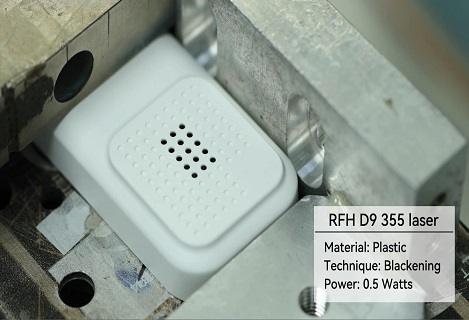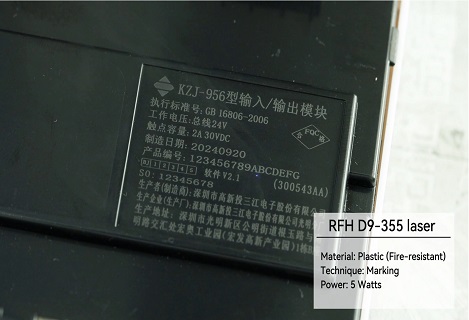Process for the uv laser marking of plastic parts
The key to laser marking plastics is achieving sufficient absorption of the laser beam into the material. In metals, most of the beam is reflected, while in plastics, transmission, diffuse reflection, and absorption are more important. The low heat conductivity in plastics means low energy losses during marking. Plastics can therefore be marked much faster than metals. Absorption by the macromolecular structure of plastics is usually in the ultraviolet and far infrared range. In additives such as carbon black or dyes, absorption occurs at varying wavelength spectrums. Since lasers with different wavelengths are available, the wavelength can be optimized for the respective material.
Which plastics can be UV laser marked?
RFH marking lasers: overview of markable plastics
Short-pulse lasers achieve good results with a range of marking types depending on the plastic, the laser wavelength and additives used. To achieve high legibility and marking quality, it is recommended to mix laser-sensitive additives into some industrial plastics. The properties of the plastics remain largely unaffected.
Laser wavelength plays an important role in the marking of plastics, depending on the application. Using frequency-doubled (532 nm, green) or tripled (355 nm, UV) solid-state lasers extends the range of plastics that are easy to mark. These lasers often achieve better results than standard systems with wavelengths of 1,064 or 1,030 nm.
What is important when marking plastics?
Plastics are materials that pose several challenges to many marking systems. The main objective of marking systems is the long-term legibility of markings, but ink, for example, has inherent limitations. Moreover, not all plastics are the same. The varying properties and additives in plastics often require individualized marking solutions. Lasers are much more flexible in coping with such challenges, tolerating even minor surface soiling, and able to begin marking immediately without having to first create templates, which is required, for example, by screen and pad printing processes.

Types of laser marking for plastics:
UV laser marking on white goods
Color change
Color change in the laser marking of plastics includes discoloration, bleaching and carbonization. Color molecules can be selectively bleached out or their color changed. Laser beam energy is used to break down or change the structure of individual molecules, such as color pigments. Surfaces remain largely unaffected and smooth. In carbonization, carbon-containing plastics burn or carbonize on the surface. The process is typically used for light-colored plastics.
UV Laser ablation, one-box lasers
Ablation
Multi-layer or coated plastics can be laser-marked by ablating a thin top layer. Contrast is created by the color of the base material or base coating. This removes coatings or special layers in laser marking film. Buttons in vehicle interiors are an example of markings achieved by layer ablation. In daylight, the symbols are white and at night they are backlit. For day and night designs, lasers with high pulse-to-pulse stability are available to ensure precise and homogeneous layer ablation.
UV laser marking on automotive plastic components
Foaming
Foaming or melting are surface-altering processes. For laser marking plastics, the laser selectively melts the matrix material, creating gas bubbles which become trapped during cooling. The resulting raised markings are about 20 to 40 μm high and relatively wide. The light is diffusely reflected, and the marking on dark plastic appears bright. Foaming is therefore usually used for black and dark colors.
How can flame-retardant or flame-resistant plastics be laser marked?
TRUMPF marking laser application in flame-retardant plastics
Especially when processing flame-retardant plastics, it is important that the material and wavelength are optimally matched to each other. Here, the use of a UV laser is recommended. Dark gray markings can then be made on light materials. Discoloration is caused by the break-up of chemical compounds. As the material does not burn or carbonize, it is referred to as "cold marking" with high surface qualities.





































